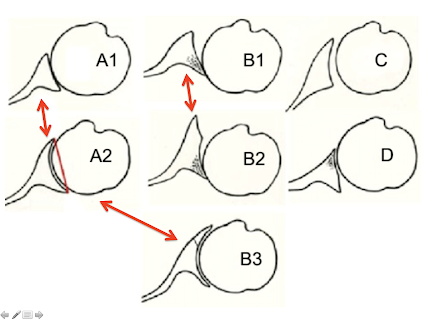There is much current interest in categorizing arthritic glenoids into types. However, as the red arrows below indicate, the differentiation among these types depends on arbitrarily set values for glenoid erosion, degree of biconcavity, and degree of retroversion.
Here is a recent case where the Grashey AP view shows severe osteoarthritis and the axillary "truth" view - taken with the arm in a position of function - shows either a B1 or B2 type glenoid (depending on whether the viewer does not or does see biconcavity).


However a CT scan taken with the arm at the side has the anterior decentering characteristic of a type D glenoid.

The patient elected a ream and run procedure to avoid the risks and limitations of a polyethylene glenoid component. This was performed as demonstrated in this link. The glenoid was reamed to a single concavity without attempting to change glenoid version. A canal sparing standard length stem was fixed with impaction autografting. An anteriorly eccentric humeral component was used to manage a tendency for excessive posterior translation identified at surgery.
His 6 week postoperative x-rays are shown below. At that time he had excellent passive motion and was transitioning to strengthening excercises.
To see a YouTube video on how the ream and run is done, click on this link.
===
How you can support research in shoulder surgery Click on this link.
We have a new set of shoulder youtubes about the shoulder, check them out at this link.
Be sure to visit "Ream and Run - the state of the art" regarding this radically conservative approach to shoulder arthritis at this link and this link
Use the "Search" box to the right to find other topics of interest to you.
You may be interested in some of our most visited web pages arthritis, total shoulder, ream and run, reverse total shoulder, CTA arthroplasty, and rotator cuff surgery as well as the 'ream and run essentials'



